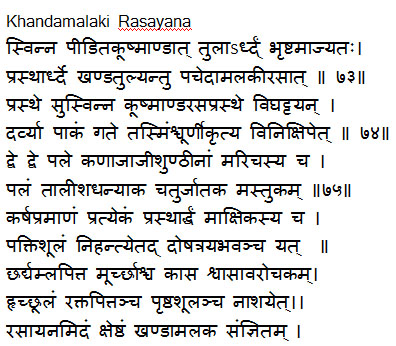Avaleha Kalpana is a popular dosage form in Ayurveda. The metabolism and absorption of this preparation starts from mouth itself.
Khanda Kalpana is same as that of Avaleha Kalpana. The essential ingredients and specific ratio remains the same for both preparations. The only difference is that, when the Avaleha preparation is boiled further and brought into granular form it is termed as Khanda Kalpana(granular mass).
Khandamalaki is a famous recipe explained in Parinamashoola Chikitsa (in the context of duodenal ulcers and gastritis) and mentioned as Rasayana Yoga – anti aging medicine in Chakradatta.
Here is how to prepare it.
Table of Contents
ToggleIngredients, spice adjuvants
Ingredients
Amalaki – Juice extract (Indian gooseberry ) – Emblica officinalis Gaertn – 1 prastha – 768 ml – in the current experiment – 500 ml
Kushmanda (Swarasa) Ash gourd juice extract – Benin casa cerifera – 1 prastha – 768 ml – 500 ml
Kushmanda (Pulp) – Ash gourd fruit pulp – Ardha Tula – 2.4 kg – 1.5 kg
Khanda – Sugar candy – Ardha Tula – 2.4 kg – 1.5 kg
Ghrita – Cow ghee – Ardha Prastha – 384 g – 250 g
Prakshepa Dravya – spice adjuvants:
Shunti – Ginger – 2 pala – 96 g – Taken in the current experiment – 60 g
Pippali – Long Pepper fruit – 2 pala – 96 g – 60 g
Jeeraka – Cumin seeds – 2 pala – 96 g – 60 g
Maricha – Black pepper – 2 pala – 96 g – 60 g
Twak – Cinnamon bark – 1 pala – 48 g – 30 g
Patra – Cinnamon leaves – Cinnamomum tamala – 48 g – 30 g
Ela – Cardamom seed – 48 g – 30 g
Nagakeshara – Mesua ferrea – Flower – 48 g – 30 g
Dhanyaka – Coriander seed – 48 g – 30 g
Musta – Cyperus rotundus – 48 g – 30 g
Talisapatra – Abies webbiana – Leaf – 48 g – 30 g
Honey – Ardha Prastha – 384 g – 250 g
Sanskrit verse

Method of preparation
PROCEDURE:
Fresh well ripened ash gourd is taken, cleaned. Outer skin and seeds are removed. Pulp is collected and grated.
Pulp is taken in a wide mouthed vessel and double quantity of water is added to the pulp and kept for boiling.
The colour of pulp will be greenish white in the beginning. As the water evaporates, bubbles appear slowly.
Pulp becomes soft and smooth.
Pulp of Kushmanda is filtered and the mass and juice are collected separately.
On the other side – Fresh Amalaki is taken, washed with water and subjected to steam for extraction of Amalaki Swarasa (fresh juice of Gooseberry).
Amalaki becomes very soft and could be easily crushed.
The seed of Amalaki is removed, squeezed and Swarasa juice extract is collected.
In stainless steel wide mouthed vessel 100 g of ghee is taken and heating is started. When it becomes warm and melts slowly little by little boiled ash gourd pulp is added and fried.
The pulp changes to semi-solid form; continued stirring is done to avoid charring.
While frying, colour of pulp turns to yellowish brown.
Bulkiness of pulp reduces and colour becomes light brown. After complete frying the quantity of Kalka (pulp) is reduced and it attains fibrous consistency.
In a wide mouthed vessel, fresh juices of Gooseberry and ash gourd are taken in equal quantities.
It is added with powder of sugar candy. It is heated with continuous stirring. The colour of mixture turns to light yellow.
Slowly the consistency of this becomes thick and sticky; then, fried Kushmanda pulp is added slowly and stirred continuously by adding little ghee (it is not mandatory to add ghee).
The colour of mass turns to dark brown colour. After heating for 10 minutes the stove is switched off, and drug is left for overnight.
On the second day:
Mass is heated continuously and temperature is maintained 900 -1000 C throughout the cooking.
When preparation becomes thick mass and attains sticky consistency, it is tested for completion tests – called Avaleha siddha lakshana.
They are –
Tantumatva – when the hot mass is taken between thumb and index fingers, 2-3 threads get formed.
Apsu Majjati – when the mass is put into water, it sinks and settles at the bottom without spreading.
Darvi Pralepa – the mass sticks to the ladle.
At this point, heating is stopped and Prakshepa – spicy powders are added and stirred well.
The mass becomes thicker; later honey is added in lukewarm state and mixed well until it attains a homogeneous form.
All the procedures should be carried out on Mandagni (mild intensity of heat).
Observations
Observations of Amalaki Swarasa and Kushmanda Swarasa:
| Parameters | Amalaki Swarasa | Kushmanda Swarasa |
| Colour | Dull green | Light green |
| Taste | Sour | Taste Less |
| Odour | Sour smell | No Smell |
| Consistency | Thick | Liquid |
Observations of Fried ash gourd pulp:
Colour – Light Brown
Odour – Pleasant Ghee Smell
Consistency – Fibrous
Taste – Sweet
Observations of Finished product will be As follows-
Colour – Dark brown
Odour – Pleasant
Taste – Sweet and Sour
Consistency – Fibrous sticky
Action, effect on dosha
Action: This formulation acts as antacid, rejuvenator, cardiac tonic and nourishes the body.
Effect on Tridosha: Balances Pitta and Vata Dosha.
Indication
Indication:
Peptic ulcer – Tridoshaja Paktishoola
Vomiting – Chardi –
Gastritis, dyspepsia – Amlapitta
Unconsciousness, fainting – Murcha
Cold, cough – asthma,
Respiratory disorders involving difficulty in breathing – Shwasa
Anorexia, lack of interest in food – Arochaka Pain in cardiac region – Hrut Shoola
Bleeding disorders like nasal bleeding, Ulcerative colitis and menorrhagia – Raktapitta
Back pain – Prushtashoola
Rejuvenating, anti aging – Rasayana
Dose, duration of use, co-drink
Dosage: 5-10 gram twice or thrice a day preferably before food or as directed by physician.
Dosage for children below 5 years of age – 1 – 2 grams, once or twice a day, along with a teaspoon of honey or warm water / milk.
Dosage for children between 5 – 12 years of age – 5 grams once or twice a day along with a teaspoon of honey or warm water / milk.
How long to use?
It can be used for up to 2- 3 months time.
Anupana – Vehicle:
For added benefits it is administered along with warm water.
Side effects, storage and shelf life
Side effects:
There are no known side effects with this medicine.
It contains sugar candy. Hence cannot be administered to diabetic patients.
Seek medical guidance for its use during pregnancy.
It can be administered during lactation and in children
Storage:
Store in a cool dry place, in air tight container. Repeated exposure to moisture and air may spoil the product.
Shelf life – 1 year
Please consult your doctor before taking this medicine.
This article is written by Dr. Janardhana V Hebbar BAMS, MD (Ayu), PGDPSM, Managing Director, Easy Ayurveda Hospital.
It is reviewed by Dr. Raviganesh Mogra BAMS, MD (Ayu), Chief Medical Officer, Easy Ayurveda Hospital









1 thought on “Khandamalaki Rasayana Uses, How To Prepare [Video]”
Please try here – http://www.esuppliersindia.com/shree-navjeevan-rasayan-shala/khandamalaki-pr875719-sFP-swf.html